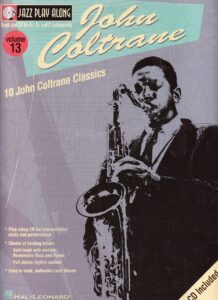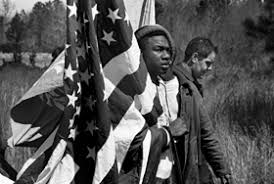Alabama: John Coltrane and Martin Luther King (1963)
On Sunday, September 15, 1963, twelve sticks of dynamite were placed in the 16th Street Baptist Church in Birmingham, Alabama. The bomb had been planted by the white supremacy group, the KKK, and killed four young black girls between the ages of 11-14.
John Coltrane wrote the song ‘Alabama’ in response to this event and patterned his playing in the song after Martin Luther King’s speech at the funeral for the four girls.

Coltrane also performed in eight benefit concerts for King in 1964 and recorded several other songs inspired by the civil rights movement called, ‘Reverend King’, ‘Backs Against the Wall’ and his album Cosmic Music dedicated to Martin Luther King.
John Coltrane wrote the song ‘Alabama’ in response to this event and patterned his playing in the song after Martin Luther King’s speech at the funeral for the four girls.
Coltrane also performed in eight benefit concerts for King in 1964 and recorded several other songs inspired by the civil rights movement called, ‘Reverend King’, ‘Backs Against the Wall’ and his album Cosmic Music dedicated to Martin Luther King.
Most people are aware of the church bombing in Birmingham that killed four children in 1963.
Missing from the story is why THIS particular church was targeted.

It’s a triumphant story, but also sheds a light on the diabolical hatred that infected (and still infects) many Americans.
Alabama, by John Coltrane
The Children’s March | 1963
American short documentary film about the Birmingham, Alabama civil rights marches in the 1960’s, highlighting the bravery of young activists involved in Children’s Crusade (1963). In 2005, this film won an Oscar at the 77th Academy Awards for Documentary Short Subject and was made by the Southern Poverty Law Center (https://www.splcenter.org/).
Brought to you by the Sheet Music Library (PDF).
Find images about Birmingham, Alabama 1963:
https://www.gettyimages.es/fotos/birmingham-alabama-1963
A little history of the facts
In April 1963 King and the Southern Christian Leadership Conference (SCLC) joined with Birmingham, Alabama’s existing local movement, the Alabama Christian Movement for Human Rights (ACMHR), in a massive direct action campaign to attack the city’s segregation system by putting pressure on Birmingham’s merchants during the Easter season, the second biggest shopping season of the year. As ACMHR founder Fred Shuttlesworth stated in the group’s “Birmingham Manifesto,” the campaign was “a moral witness to give our community a chance to survive” (ACMHR, 3 April 1963).
The campaign was originally scheduled to begin in early March 1963, but was postponed until 2 April when the relatively moderate Albert Boutwell defeated Birmingham’s segregationist commissioner of public safety, Eugene “Bull” Connor, in a run-off mayoral election. On 3 April the desegregation campaign was launched with a series of mass meetings, direct actions, lunch counter sit-ins, marches on City Hall, and a boycott of downtown merchants. King spoke to black citizens about the philosophy of nonviolence and its methods, and extended appeals for volunteers at the end of the mass meetings. With the number of volunteers increasing daily, actions soon expanded to kneel-ins at churches, sit-ins at the library, and a march on the county building to register voters. Hundreds were arrested.
On 10 April the city government obtained a state circuit court injunction against the protests. After heavy debate, campaign leaders decided to disobey the court order. King declared: “We cannot in all good conscience obey such an injunction which is an unjust, undemocratic and unconstitutional misuse of the legal process” (ACMHR, 11 April 1963). Plans to continue to submit to arrest were threatened, however, because the money available for cash bonds was depleted, so leaders could no longer guarantee that arrested protesters would be released. King contemplated whether he and Ralph Abernathy should be arrested. Given the lack of bail funds, King’s services as a fundraiser were desperately needed, but King also worried that his failure to submit to arrests might undermine his credibility. King concluded that he must risk going to jail in Birmingham. He told his colleagues: “I don’t know what will happen; I don’t know where the money will come from. But I have to make a faith act” (King, 73).
On Good Friday, 12 April, King was arrested in Birmingham after violating the anti-protest injunction and was kept in solitary confinement. During this time King penned the“Letter from Birmingham Jail” on the margins of the Birmingham News, in reaction to a statement published in that newspaper by eight Birmingham clergymen condemning the protests. King’s request to call his wife, Coretta Scott King, who was at home in Atlanta recovering from the birth of their fourth child, was denied. After she communicated her concern to the Kennedy administration, Birmingham officials permitted King to call home. Bail money was made available, and he was released on 20 April 1963.
In order to sustain the campaign, SCLC organizer James Bevel proposed using young children in demonstrations. Bevel’s rationale for the Children’s Crusade was that young people represented an untapped source of freedom fighters without the prohibitive responsibilities of older activists. On 2 May more than 1,000 African American students attempted to march into downtown Birmingham, and hundreds were arrested. When hundreds more gathered the following day, Commissioner Connor directed local police and fire departments to use force to halt the demonstrations. During the next few days images of children being blasted by high-pressure fire hoses, clubbed by police officers, and attacked by police dogs appeared on television and in newspapers, triggering international outrage. While leading a group of child marchers, Shuttlesworth himself was hit with the full force of a fire hose and had to be hospitalized. King offered encouragement to parents of the young protesters: “Don’t worry about your children, they’re going to be alright. Don’t hold them back if they want to go to jail. For they are doing a job for not only themselves, but for all of America and for all mankind” (King, 6 May 1963).
In the meantime, the white business structure was weakening under adverse publicity and the unexpected decline in business due to the boycott, but many business owners and city officials were reluctant to negotiate with the protesters. With national pressure on the White House also mounting, Attorney General Robert Kennedy sent Burke Marshall, his chief civil rights assistant, to facilitate negotiations between prominent black citizens and representatives of Birmingham’s Senior Citizen’s Council, the city’s business leadership.
The Senior Citizen’s Council sought a moratorium on street protests as an act of good faith before any final settlement was declared, and Marshall encouraged campaign leaders to halt demonstrations, accept an interim compromise that would provide partial success, and negotiate the rest of their demands afterward. Some black negotiators were open to the idea, and although the hospitalized Shuttlesworth was not present at the negotiations, on 8 May King told the negotiators he would accept the compromise and call the demonstrations to a halt.
When Shuttlesworth learned that King intended to announce a moratorium he was furious—about both the decision to ease pressure off white business owners and the fact that he, as the acknowledged leader of the local movement, had not been consulted. Feeling betrayed, Shuttlesworth reminded King that he could not legitimately speak for the black population of Birmingham on his own: “Go ahead and call it off … When I see it on TV, that you have called it off, I will get up out of this, my sickbed, with what little ounce of strength I have, and lead them back into the street. And your name’ll be Mud” (Hampton and Fayer, 136). King made the announcement anyway, but indicated that demonstrations might be resumed if negotiations did not resolve the situation shortly.
By 10 May negotiators had reached an agreement, and despite his falling out with King, Shuttlesworth joined him and Abernathy to read the prepared statement that detailed the compromise: the removal of “Whites Only” and “Blacks Only” signs in restrooms and on drinking fountains, a plan to desegregate lunch counters, an ongoing “program of upgrading Negro employment,” the formation of a biracial committee to monitor the progress of the agreement, and the release of jailed protesters on bond (“The Birmingham Truce Agreement,” 10 May 1963).
Birmingham segregationists responded to the agreement with a series of violent attacks. That night an explosive went off near the Gaston Motel room where King and SCLC leaders had previously stayed, and the next day the home of King’s brother Alfred Daniel King was bombed. President John F. Kennedy responded by ordering 3,000 federal troops into position near Birmingham and making preparations to federalize the Alabama National Guard. Four months later, on 15 September, Ku Klux Klan members bombed Birmingham’s Sixteenth Street Baptist Church, killing four young girls. King delivered the eulogy at the 18 September joint funeral of three of the victims, preaching that the girls were “the martyred heroines of a holy crusade for freedom and human dignity” (King, “Eulogy for the Martyred Children,” 18 September 1963).
